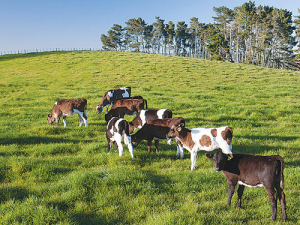Providing pain relief when disbudding calves is not mandated by regulation but it is coming, says DairyNZ animal husbandry specialist Bruce Eyers.
Public perception and market access will be the drivers, he told a Dairy Womens Network workshop in Wellsford recently.
While not yet mandatory, use of a local anaesthetic is the recommended practice for disbudding calves, for a number of reasons, the workshop heard.
Use of an anti-inflammatory after the procedure is also recommended although is it unlikely to become a rule at this stage.
Eyers told the workshop that in their wild state cattle are animals of prey. As a survival technique, cattle try to avoid displaying pain which would indicate they could be a weaker animal in a herd.
“So when they are demonstrating pain… they are in a lot of pain.”
Indicators of pain in calves include tail shaking, ear twitching, eating less, restlessness, less playfulness, avoiding touch and increased cortisol (a stress hormone).
Looking at stress responses, without pain relief after disbudding it takes a calf at least 24 hours for the pain to subside and 40 hours before it has recovered from the painful experience. With the use of local anaesthetic, initially there is no pain but after three to four hours as it wears off they start to feel sore.
With pain relief and the addition of anti-inflammatories to reduce swelling around the disbudded site, pain is reduced significantly.
“There are definitely benefits to doing the two; and there are definitely adverse effects if you don’t do anything at all,” Eyers says.
Another option is also to completely sedate the calf to preclude stress but this does not provide pain relief in itself; a local anaesthetic is still required to reduce pain.
The advantage of sedating is that it is less stressful for the calf; they are easier to handle and you can do other jobs as well. And sedation makes the handler’s job easier, particularly in large herds.
Even if you don’t sedate them there are definite benefits to local anaesthetics and anti-inflammatories: pain relief causes animals to grow better; pain relief reduces the growth check. Extra body weight means calves can be weaned earlier. That provides significant financial benefit to the farm business.
You do not need to be a vet to administer a local anaesthetic for disbudding but you need a prescription for the drug and a veterinary operating instruction (VOI). This relatively simple process shows capability in administering the pain relief in the right manner for it to work, doing so safely and understanding the side effects. Obtaining the VOI needs to be done seasonally, but the training is only needed once.
Farmers should try to ensure those who provide the training or services have plenty of experience in that field.
A calf can be disbudded when the bud can be felt. Less than eight weeks is the ideal; most people are disbudding between two and six weeks.
The minimum age where you must use a local anaesthetic by law for any procedure is nine months, or six months to castrate a bull.
A misconception that pops up repeatedly with farmers is they assume the antibacterial ‘purple spray’ is anti-inflammatory. It is obviously useful as an anti-bacterial but it provides no pain relief.
Eyers says the other issues surrounding disbudding are public perception and market access.
Use of local anaesthetic for disbudding is coming as a regulatory requirement, he says. “It is not here yet but it is coming.”
Sedation and anti-inflammatories will not be part of that mandatory process at this stage.
DairyNZ currently has a programme study underway called Heads and Tails to keep farmers ahead of the game on regulatory requirements.


















